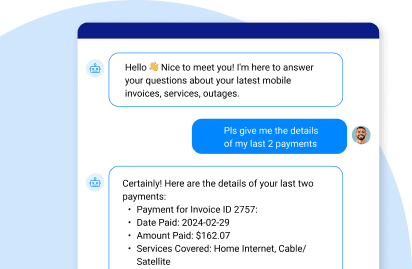Grounding is a method designed to reduce AI hallucinations (false or misleading info made up by GenAI apps) by anchoring LLM responses in enterprise data.
What are hallucinations in AI?
Although according to Gartner Generative AI (GenAI) analysts, 2024 will witness companies moving from GenAI explorations to pilot executions, the Large Language Models (LLMs) behind GenAI often produce incorrect or nonsensical outputs, known as "AI hallucinations".
Simply put, an AI hallucination is an output that deviates from real-life facts. One way to make your outputs more factual is to use Retrieval-Augmented Generation (RAG), an AI framework that helps prevent hallucinations via LLM grounding. More on RAG in the following sections.
AI hallucinations happen because LLMs may:
-
Be trained on bad data
If the AI data is faulty or incomplete, the model will reflect these flaws in its outputs. For example, if an AI chatbot was trained on a dataset of historical articles filled with factual errors, it might mistakenly place the Battle of the Bulge in Japan.
-
Draw the wrong conclusions
When an LLM identifies false data patterns or connections, it’s called overfitting. For instance, an AI email writer trained on a massive dataset of business emails might mistakenly conclude that every email requesting a meeting should end with the phrase "Looking forward to meeting you [kitten GIF]" – because it saw this closing line used in several successful emails and then mistakenly generalized it to include all meeting requests.
AI hallucinations can have all kinds of consequences, from amusing (like the kitten GIF) to far more serious. For example, if an AI-based financial model overfits on historical data and misses a shift in consumer behavior, the result might be losses for investors who relied on its advice.
One way to avoid AI hallucinations is to improve training data by fine-tuning it. Another is to compare AI outputs against real-world knowledge bases to reveal inconsistencies. An enterprise interested in hedging its bets by employing both methods would be well advised to consider its very own RAG tool.
Get a condensed version of the Gartner RAG report thanks to K2view.
What is grounding in AI?
Grounding is a method of reducing AI hallucinations by anchoring the LLM's responses in real-time enterprise data. It’s kind of like giving the LLM a fact-checker.
More specifically, grounding works by connecting the LLM’s understanding of language to actual data. Specific language on a niche subject, learnable from publicly available and private enterprise sources, might not have been included in the LLM’s initial training. Grounding acts as a bridge, linking the abstract language the LLM understands with concrete, real-world events and situations.
There are number of AI grounding techniques. As discussed, RAG GenAI extends the capabilities of LLMs to include structured and unstructured data from an organization's own internal systems – without retraining the model.
RAG conversational AI is a cost-effective approach to enhancing LLM output, ensuring it remains relevant, accurate, and useful in many different contexts.
In the retrieval-augmented generation vs fine-tuning comparison, fine-tuning also serves to ground LLMs, but only on specific tasks. As textual responses are generated, fine-tuning compares them against real-world knowledge bases like scientific publications, verified news articles, and private enterprise data. Inconsistencies get flagged, prompting the AI to refine its output based on factual grounding.
How does grounding work?
Grounding is a continuous refinement process to ensure the LLM leverages real-world data effectively. Here's how it works in 4 steps:
-
Data selection
The grounding tool, such as one based on RAG AI, chooses the most appropriate data for the LLM, whether sourced from structured enterprise data or unstructured docs.
-
Knowledge representation
The selected data needs to be in a format the LLM understands via "embedding" (transforming the data into numerical codes) or "knowledge graphing" (visually linking the information).
-
Retrieval mechanism
Active retrieval-augmented generation helps the LLM locate the most relevant data for its purposes. Enterprise-wide search functionality and APIs are critical to these efforts.
-
Integration
The retrieved data is incorporated into the LLM's reasoning and response process by way of "in-context learning" (feeding relevant data directly into prompts) or "memory augmentation" (storing external knowledge for easy reference).
By iteratively refining these steps, grounding ensures the LLM leverages both publicly available information and private enterprise data to generate the most accurate and relevant responses.
Halt hallucinations with GenAI Data Fusion
Grounding LLMs to eliminate AI hallucinations – including RAG hallucinations – is most effective using GenAI Data Fusion, a unique RAG approach that retreives and augments both structured and unstructured data from any source. It unifies data for each business entity (customer, vendor, device, or other) from enterprise systems based on the data-as-a-product philosophy.
Data products let GenAI Data Fusion access real-time data from a multitude of enterprise systems, in addition to docs from knowledge bases. For example, you could turn the data found in your customer 360 platforms into highly meaningful contextual prompts. Feed these prompts into your LLM together with the original query, and benefit from more accurate and personalized responses every time.
With the K2View data product platform, RAG can access data products via any combination of messaging, streaming, API, or CDC to aggregate data from a wide variety of source systems. A data product approach can be applied to many different RAG use cases to:
-
Resolve issues faster.
-
Create hyper-personalized marketing campaigns.
-
Personalize cross-/up-sell suggestions.
-
Detect fraud by identifying unusual activity in user accounts.
Avoid AI hallucinations by grounding LLMs with GenAI
Data Fusion by K2view – the industry-leading RAG tool.













